No products in the cart.
June 19, 2024 7:10 pm
June 19, 2024 7:10 pm
In the chilly shadows of European winter folklore, the figure of Krampus emerges, distinct with its horns and sinister demeanor.
This creature, often misunderstood and wrongly associated with Norse mythology, actually roots itself deeply in Central European traditions.
Unlike the gods and creatures of Norse lore, Krampus serves a specific role in the Christmas season, acting as a stark counterpart to the benevolent Saint Nicholas.
This introduction will dispel common myths and set the foundation for exploring the true origins of Krampus, emphasizing its unique cultural significance that stands apart from the figures of Norse paganism.
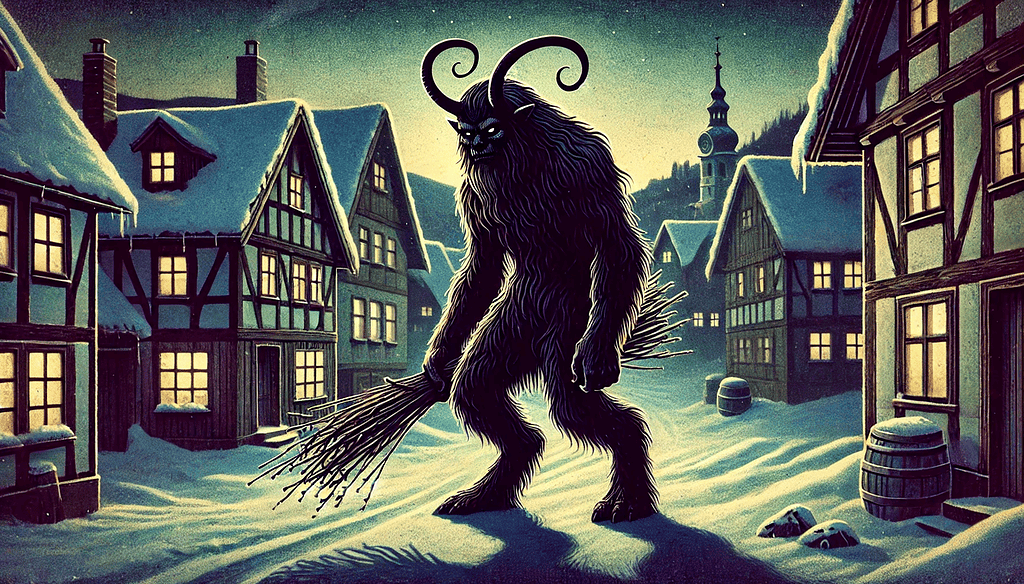
Krampus is a folklore figure prominently featured in the traditions of the German state of Bavaria (and even there, the Krampus is only known throughout the most southern and eastern regions bordering Austria) and Austria.
Unlike the benevolent and gift-giving Saint Nicholas, Krampus appears as a fearsome creature, often depicted with dark, shaggy fur, cloven hooves, and horns reminiscent of a goat.
This stark figure is typically associated with the event known as Krampusnacht, occurring on December 5th, when this Christmas devil is said to visit the homes of misbehaving children.
The image of Krampus is a composite of various folkloric components that symbolize punishment and fear.
Equipped with chains and bells that clatter ominously, Krampus carries hazel branches, used to swat at naughty children, and sometimes a sack or basket to carry them away.
This portrayal, however, has post-Christianization overlays which utilized such menacing figures to instill moral discipline.
Its pre-Christian origins are of course much older and much more multifaceted.
And as we know by the ethnographic research done by Marie-Andree Eysn, even the masks themselves and thus the appearance of Krampus itself has undergone major change over hundreds and hundreds of years.
The demonic/devilish-appearance being an obviously rather recent one.
In the heart of Central European folklore, Krampus is not just a solitary figure but part of a broader cultural observance that balances the scales of holiday cheer with a touch of fear.
During Krampuslauf, a popular event, people dress up as Krampus and parade through streets, a vivid reminder of the creature’s role in local traditions.
This celebration starkly contrasts with Norse mythology, where no direct equivalent of Krampus exists. Instead, Norse tales often explore themes of bravery, fate, and the mystical elements of nature, with creatures that serve different symbolic purposes.
It is crucial for enthusiasts of Norse mythology and paganism to understand that Krampus does not originate from Norse lore.
The creature’s roots are firmly planted in the Germanic and Austrian traditions, intertwined with the Christianization of pagan customs.
The Allgaeu region of Bavaria, Upper & Lower Bavaria and its eastern borders and parts of Austria have Germanic-Alemannic and Celtic roots.
The word for the German state Bavaria itself derives its name from a pagan tribe, the Bajuvarii.
The Austrian Tyrol and Vorarlberg, Bavarian-Swabia and the Allgaeu region belong to the former Alemannic tribal territory.
The administrative region of Bavaria, Swabia, also derives its name from a former pagan tribe, the Suevi.
In Germany, the Krampuslauf is predominantly practiced by Swabians and Bavarians.
It is not practiced in the northern half of the country.
Neither the Bajuvarii nor the Alemannic tribes of this region belonged to the North Germanic language family but to the West Germanic branch of the Germanic languages (The Eastern branch is extinct!).
There is hence no reason to assume a Norse origin if Krampus is of a pre-Christian pagan origin.
This clear distinction helps in appreciating Krampus within its proper cultural and historical context, recognizing it as a unique element of Alpine heritage rather than a misplaced figure from Norse tales.
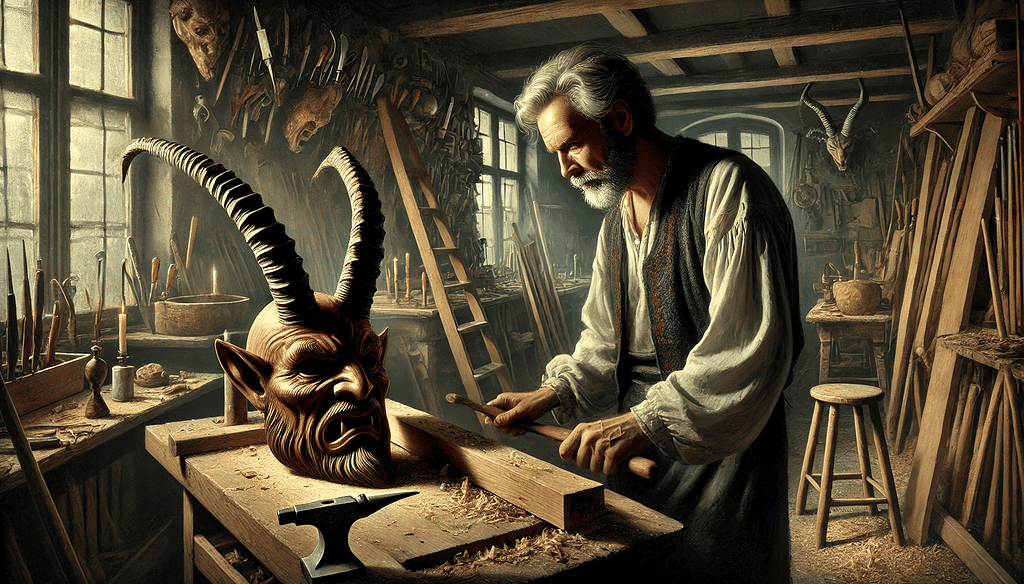
Krampus’s origins are steeped in the folk traditions of the Alpine regions, particularly within Austrobavarian spheres and its native Dialects and also its unique set of mythological legends and tales.
This character likely emerged from pagan rituals that Christian missionaries such as the Bishop Burchard of Worms, and the Bishop of Wuerzburg from northern Bavaria denounced and rejected as ‘animal worship’ and ‘elk masquerades’.
In their Christian missionary texts, they tell of a set of local traditions that the native population dress as animals (hereby in particular as elk) throughout the time of New Year’s in order to bring Good luck blessings, rather than fear and punishment which appears to be a more recent Christian overlay.
The latter likely developed after the 15th Century when the masquerades were under political attack.
It was for instance punishable to even own a mask.
As Christianity spread across Europe, many pagan customs were integrated into Christian traditions, with Krampus evolving into a counterpart to Saint Nicholas in the pre-Christmas festivities.
This blending illustrates the survival of ancient beliefs through adaptation, rather than a direct continuation of any single mythological tradition.
Krampus is intrinsically linked to the Christmas season, specifically through Krampusnacht, which occurs on December 5th, the eve of Saint Nicholas Day.
While Saint Nicholas rewards well-behaved children with gifts, Krampus serves as a deterrent for those who have misbehaved.
This dualistic approach to December festivities highlights a balance between reward and punishment, a common theme in many cultural traditions but particularly poignant in the Alpine celebration of Christmas.
Krampusnacht celebrations vary significantly from region to region but generally involve elaborate costumes, parades, and sometimes frightening performances.
In Austria and parts of Bavaria, the night is marked by the Krampuslauf, where individuals dressed as Krampus roam the streets, creating a spectacle that combines horror with festivity.
They are accompanied by other mythological characters inherent to the local mythological lore that informs these Winter masquerades.
Such characters also involve the Baerentreiber (bear-driver), Perchta and the Buttnmandl strawbears.
This event serves not only as a reminder of the darker aspects of folklore but also as a community activity that reinforces social bonds.
Similar figures appear in neighboring countries, each adapting the Krampus theme to local customs, showing the widespread influence of this figure across Central European culture.
In modern times, Krampus has become a symbol of cultural identity for local Bavarian and Austrian communities, embodying a unique aspect of their heritage that distinguishes them from the globalized Santa Claus narrative.
This resurgence in popularity is a form of cultural preservation, celebrating a figure that encapsulates the historical depth and complexity of local traditions, ensuring that Krampus remains a relevant and cherished part of Alpine folklore.
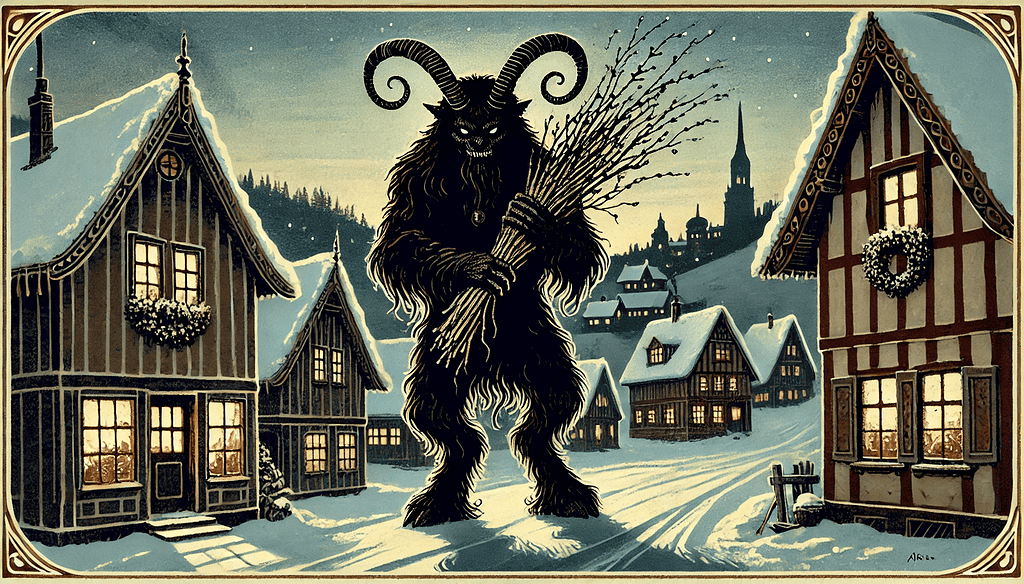
One prevailing misconception is the affiliation of Krampus with Norse mythology.
Despite its popularity in regions steeped in Germanic languages—a linguistic cousin to Old Norse—the Krampus tradition does not trace back to Viking or ancient Scandinavian cultures.
A Germanic heritage does not necessarily imply a Scandinavian or Norse origin.
As the Germanic heritage of these regions is primarily Allemannic and also of Celtic origin, we are dealing with a West Germanic heritage, not a North Germanic one.
Krampus is a product of Central European folklore, particularly from Alpine regions like Austria and Bavaria, where it evolved separately from the mythologies of the Norse gods.
This clarification is crucial for understanding the distinct cultural identities that shape different European mythologies.
The frequent comparison between Krampus and Loki, a well-known trickster god from Norse mythology, likely stems from their shared attributes of mischief and punishment.
However, Loki’s role extends far beyond that of a mere punisher; he is a complex deity involved in creation, chaos, and transformation within the Norse pantheon, which contrasts sharply with Krampus’s singular role as a punisher of naughty children during the Christmas season.
Another point of confusion arises with Hel, the Norse goddess of the underworld, sometimes mentioned in myths about Krampus’s origins.
This association likely confuses Hel, a deity overseeing the dead in Norse lore, with the Christian and pagan imagery of devils and demonic beings associated with the underworld in European folklore.
This conflation misrepresents both traditions, as Krampus’s punitive role during Christmas has no direct correlation to the governance and moral judgements found in Norse mythology.
Understanding these distinctions helps reinforce the unique cultural roots of Krampus without erroneously blending it with Norse mythology.
Such clarity not only respects the integrity of Norse mythological studies but also preserves the rich heritage and regional variations of Alpine folklore that gave rise to the Krampus figure.
This awareness fosters a more accurate appreciation of European cultural diversity, especially among audiences deeply interested in the historical and mythological narratives of different European regions.
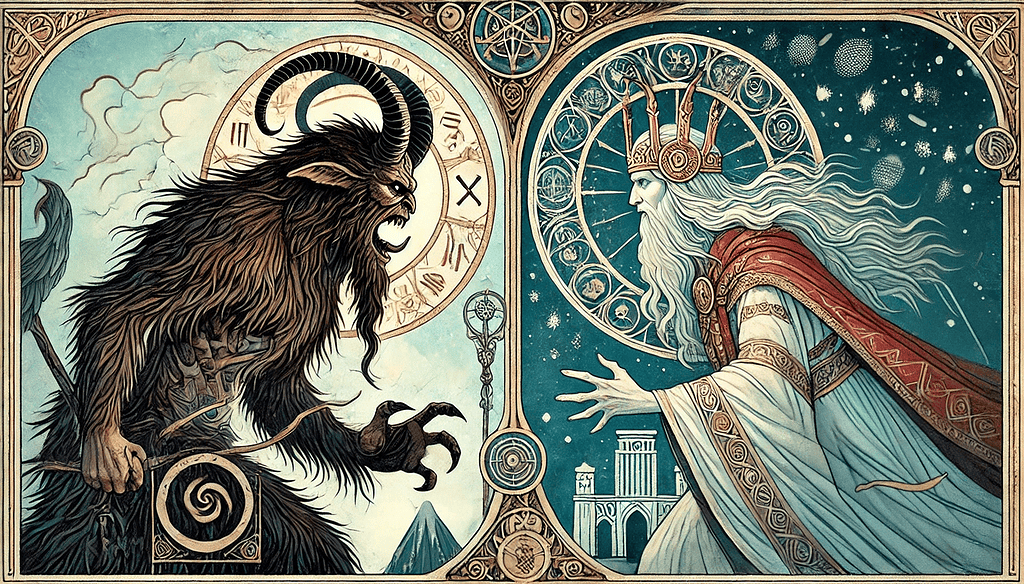
In the tapestry of European Christmas folklore, Saint Nicholas and Krampus represent contrasting forces of good and punishment.
Saint Nicholas, revered as a benevolent figure, rewards well-behaved children with gifts and praise on the eve of his feast day, December 6th. In stark contrast, Krampus serves as the enforcer of moral conduct.
On Krampusnacht, celebrated on December 5th, he visits the homes of children who have misbehaved throughout the year, wielding hazel sticks and a threatening presence to instill fear and encourage better behavior in the coming year.
The pairing of Krampus with Saint Nicholas illustrates a profound lesson in moral and ethical balance, reflective of older, pre-Christian beliefs where such dualities governed social and spiritual life.
This partnership underscores a common theme in folklore worldwide—the balance of light and dark, reward and retribution.
In many regions, particularly in the Alpine countries, this duality is celebrated with public parades and gatherings, showcasing elaborate costumes and dramatic enactments of Krampus’s pursuit of naughty children, followed by the benevolent appearance of Saint Nicholas.
The interplay between Krampus and Saint Nicholas not only entertains but also serves a social function, reinforcing community norms and behavioral expectations among the young.
This dynamic duo of folklore has permeated deeper into cultural identity, particularly in Austria and southern Germany, where these figures are integral to annual Christmas traditions.
While Saint Nicholas promotes generosity and kindness, Krampus provides a stark reminder of the consequences of errant behavior, maintaining a balance that is crucial for community cohesion and cultural continuity.
This relationship between Krampus and Saint Nicholas offers a fascinating glimpse into how folklore can be used to govern moral behavior through storytelling.
It demonstrates the effectiveness of myth in shaping cultural and social values, ensuring that these lessons resonate through generations in engaging and memorable ways.
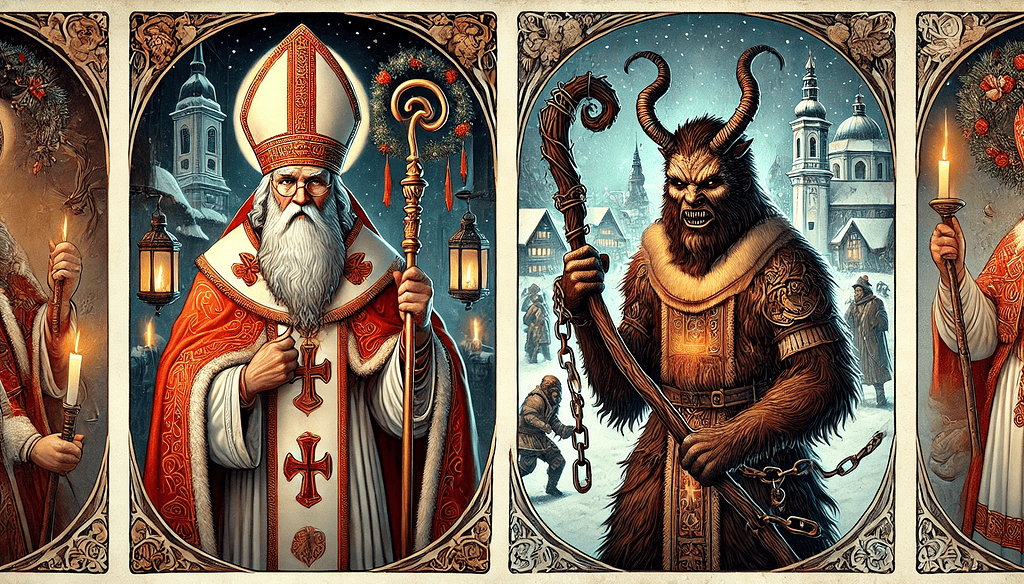
The Wild Hunt, a spectral phenomenon rooted deeply in Germanic folklore, particularly in Bavaria, features a host of ghostly hunters, led by a mythical figure often associated with Wodan.
In Bavaria he is referred to as Berchthold (Perchta’s beloved one), Schimmelreiter (riding a white horse), and wilder Jaeger (wild hunter).
As we know by scholars such as Rudolf Simek, Karl Simrock and Wolfgang Menzel, the Wild Hunt myths in this region deals with reverence to Dead ancestors on their way back to rebirth.
Additionally the reenforcement of fertility and protective aspects in regards to crops, harvest and future abundance in regards to livestock, harvest and surviving the often cold and long winters of the Alps.
This event is said to occur during the winter months, sweeping across the sky with fierce winds and thunderous noises.
The imagery of the Wild Hunt is rich with symbolism, representing the forces of nature and the passage of spirits.
While not directly linked to Krampus, the Wild Hunt shares thematic elements of awe and reverence for the supernatural forces that govern the natural world.
Both Krampusnacht and the Wild Hunt embody the darker, more formidable aspects of folklore during the winter season, a time historically associated with introspection and respect for the forces beyond human control.
This connection enriches the cultural tapestry of Bavarian and broader Central European folklore, showcasing how different legends intersect to paint a comprehensive picture of the region’s mythological heritage.
In Bavaria, the Wild Hunt serves as a reminder of humanity’s place within the larger cosmos, a theme echoed in the story of Krampus, who himself acts as a moral enforcer during a season marked by long nights and cold days.
The tale of the Wild Hunt adds another layer to the winter season’s folklore, emphasizing that these stories, while sometimes fearsome, are meant to foster community cohesion and continuity of cultural traditions.
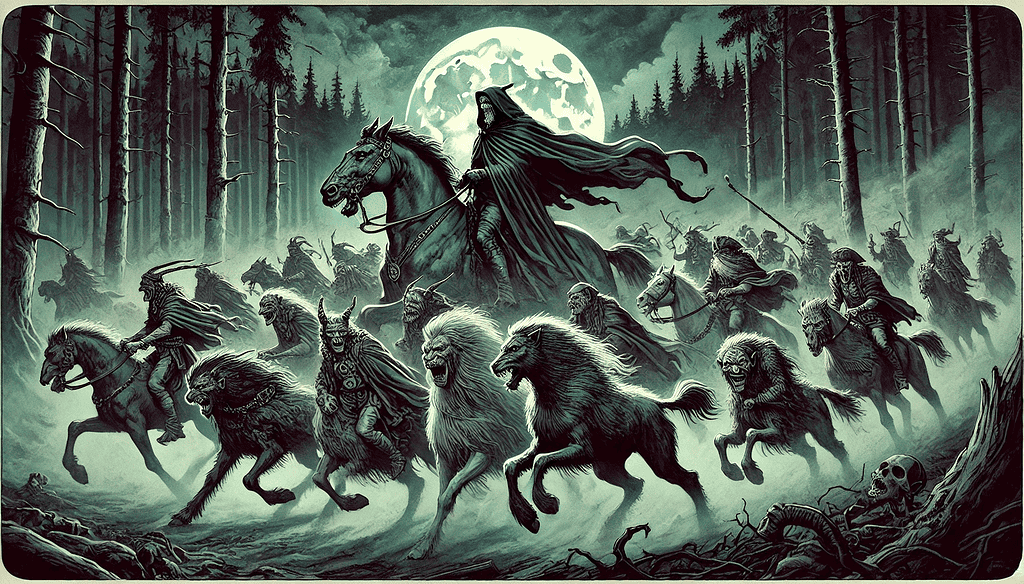
Krampus serves as more than just a seasonal scare; it acts as a vital link to the cultural heritage of Central European communities.
This figure, with its deep roots in Alpine folklore, plays a crucial role in the cultural preservation and education of a region rich with historical traditions.
The resurgence of Krampus in contemporary celebrations helps breathe new life into these traditions, ensuring they remain relevant and engaging for future generations.
The intrigue surrounding Krampus has crossed borders, making it a figure of global curiosity and fascination.
This expansion into global consciousness highlights the increasing appreciation for diverse cultural narratives around the world.
As Krampus events and representations proliferate worldwide, they underscore the universal appeal of rich, culturally significant folklore.
Krampus’s enduring popularity reaffirms the power of folklore to connect us to our past, while simultaneously enriching our global cultural tapestry.